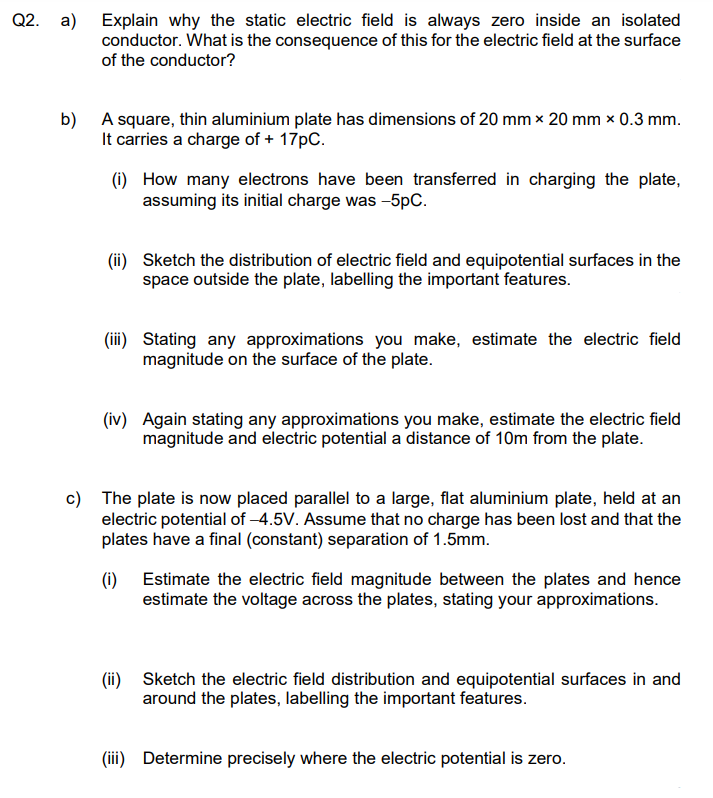Q2. a) Explain why the static electric field is always zero inside an isolated conductor. What is the consequence of this for the electric field at the surface of the conductor? b) A square, thin aluminium plate has dimensions of 20 mm x 20 mm x 0.3 mm. It carries a charge of + 17pC. (i) How many electrons have been transferred in charging the plate, assuming its initial charge was -5pC. (ii) Sketch the distribution of electric field and equipotential surfaces in the space outside the plate, labelling the important features. (iii) Stating any approximations you make, estimate the electric field magnitude on the surface of the plate. (iv) Again stating any approximations you make, estimate the electric field magnitude and electric potential a distance of 10m from the plate. c) The plate is now placed parallel to a large, flat aluminium plate, held at an electric potential of -4.5V. Assume that no charge has been lost and that the plates have a final (constant) separation of 1.5mm. (i) Estimate the electric field magnitude between the plates and hence estimate the voltage across the plates, stating your approximations. (ii) Sketch the electric field distribution and equipotential surfaces in and around the plates, labelling the important features. (iii) Determine precisely where the electric potential is zero.
Q2. a) Explain why the static electric field is always zero inside an isolated conductor. What is the consequence of this for the electric field at the surface of the conductor? b) A square, thin aluminium plate has dimensions of 20 mm x 20 mm x 0.3 mm. It carries a charge of + 17pC. (i) How many electrons have been transferred in charging the plate, assuming its initial charge was -5pC. (ii) Sketch the distribution of electric field and equipotential surfaces in the space outside the plate, labelling the important features. (iii) Stating any approximations you make, estimate the electric field magnitude on the surface of the plate. (iv) Again stating any approximations you make, estimate the electric field magnitude and electric potential a distance of 10m from the plate. c) The plate is now placed parallel to a large, flat aluminium plate, held at an electric potential of -4.5V. Assume that no charge has been lost and that the plates have a final (constant) separation of 1.5mm. (i) Estimate the electric field magnitude between the plates and hence estimate the voltage across the plates, stating your approximations. (ii) Sketch the electric field distribution and equipotential surfaces in and around the plates, labelling the important features. (iii) Determine precisely where the electric potential is zero.
Introductory Circuit Analysis (13th Edition)
13th Edition
ISBN:9780133923605
Author:Robert L. Boylestad
Publisher:Robert L. Boylestad
Chapter1: Introduction
Section: Chapter Questions
Problem 1P: Visit your local library (at school or home) and describe the extent to which it provides literature...
Related questions
Question
Q2 Part C please

Transcribed Image Text:Q2. a) Explain why the static electric field is always zero inside an isolated
conductor. What is the consequence of this for the electric field at the surface
of the conductor?
b) A square, thin aluminium plate has dimensions of 20 mm x 20 mm x 0.3 mm.
It carries a charge of + 17pC.
(i) How many electrons have been transferred in charging the plate,
assuming its initial charge was -5pC.
(ii) Sketch the distribution of electric field and equipotential surfaces in the
space outside the plate, labelling the important features.
(iii) Stating any approximations you make, estimate the electric field
magnitude on the surface of the plate.
(iv) Again stating any approximations you make, estimate the electric field
magnitude and electric potential a distance of 10m from the plate.
c) The plate is now placed parallel to a large, flat aluminium plate, held at an
electric potential of -4.5V. Assume that no charge has been lost and that the
plates have a final (constant) separation of 1.5mm.
(i) Estimate the electric field magnitude between the plates and hence
estimate the voltage across the plates, stating your approximations.
(ii) Sketch the electric field distribution and equipotential surfaces in and
around the plates, labelling the important features.
(iii) Determine precisely where the electric potential is zero.
Expert Solution
This question has been solved!
Explore an expertly crafted, step-by-step solution for a thorough understanding of key concepts.
Step by step
Solved in 4 steps with 2 images

Knowledge Booster
Learn more about
Need a deep-dive on the concept behind this application? Look no further. Learn more about this topic, electrical-engineering and related others by exploring similar questions and additional content below.Recommended textbooks for you

Introductory Circuit Analysis (13th Edition)
Electrical Engineering
ISBN:
9780133923605
Author:
Robert L. Boylestad
Publisher:
PEARSON

Delmar's Standard Textbook Of Electricity
Electrical Engineering
ISBN:
9781337900348
Author:
Stephen L. Herman
Publisher:
Cengage Learning

Programmable Logic Controllers
Electrical Engineering
ISBN:
9780073373843
Author:
Frank D. Petruzella
Publisher:
McGraw-Hill Education

Introductory Circuit Analysis (13th Edition)
Electrical Engineering
ISBN:
9780133923605
Author:
Robert L. Boylestad
Publisher:
PEARSON

Delmar's Standard Textbook Of Electricity
Electrical Engineering
ISBN:
9781337900348
Author:
Stephen L. Herman
Publisher:
Cengage Learning

Programmable Logic Controllers
Electrical Engineering
ISBN:
9780073373843
Author:
Frank D. Petruzella
Publisher:
McGraw-Hill Education

Fundamentals of Electric Circuits
Electrical Engineering
ISBN:
9780078028229
Author:
Charles K Alexander, Matthew Sadiku
Publisher:
McGraw-Hill Education

Electric Circuits. (11th Edition)
Electrical Engineering
ISBN:
9780134746968
Author:
James W. Nilsson, Susan Riedel
Publisher:
PEARSON

Engineering Electromagnetics
Electrical Engineering
ISBN:
9780078028151
Author:
Hayt, William H. (william Hart), Jr, BUCK, John A.
Publisher:
Mcgraw-hill Education,